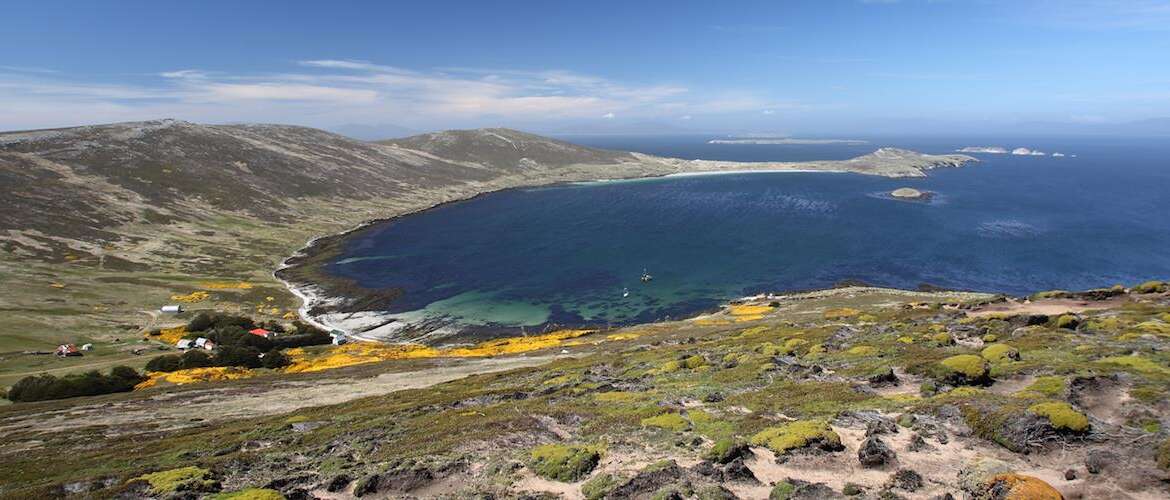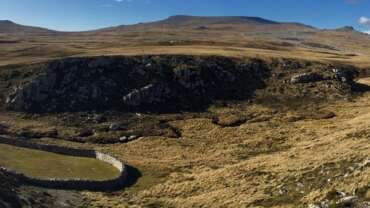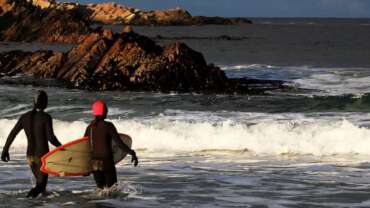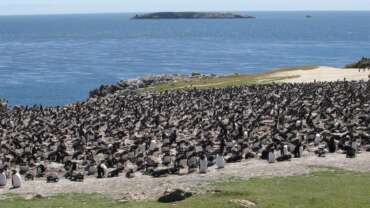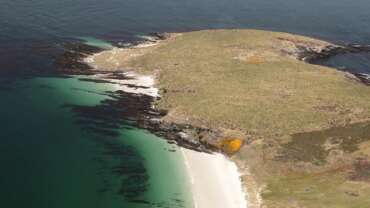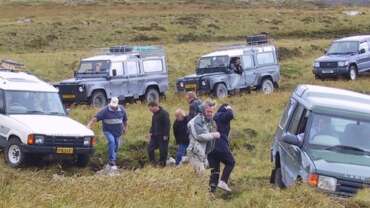Falkland Islands - The Islands
Scattered around the edges of East and West Falkland are many smaller islands, making up the archipelago. Most are home only to flora and fauna with no human presence. Visitors can step ashore on a small number of these amazing little islands.
Each island has its own distinct character with different experiences and wildlife to enjoy. Some feature as part of cruise itineraries, some have accommodation, some welcome both cruise and island-hopping visitors.
Wildlife experiences are second-to-none. Whichever small island you visit you will find some of the best that the Falklands has to offer. From the magnificent black-browed albatross to the tiny Cobb’s wren, tall tussac grass to the delicate Lady’s Slipper, discover endemic and native species in profusion. Sightings are guaranteed, up close and personal!
Cruise passengers begin their small island adventures with a zodiac (inflatable small craft) ride from ship to shore. From the landing point, exhilarating walks lead to wildlife colonies and sometimes a traditional Falkland home with a warm welcome to smoko.
At least one small island should be part of any longer-stay visitor itinerary. A minimum of two nights is recommended, three if time allows. This is where you will truly appreciate a sense of isolation, experiencing that wonderful feeling when you realise that as you are out-and-about you will meet no strangers; in fact it’s quite likely you will meet no-one at all. The only sounds surrounding you are those of wind, waves and wildlife.
Your adventure begins with arrival by Islander aircraft, after which you can relax and let your host take care of everything. You will soon feel like an old friend as you quickly become part of the everyday life of the island. Join in with farming activities, take tours or time-out on your own. This is the essence of the Falkland experience.
Bleaker Island
Bleaker Island, first known as Long Island then became Breaker Island after the large waves that crash on the shores. Situated in the south-east of the Falklands’ archipelago it is not bleak at all and, as there is no land of any great height, the highest point Semaphore Hill is just 27 metres (89 feet), it is very easy to explore.
Bleaker is scenically attractive with a stunning long beach known as Sandy Bay. Most of the birdlife can be found on this beach or close by on the ponds. There is a long list of birds to observe.
Gentoo penguins inhabit the north end of Sandy Bay. Heading south from here to an area called Long Gulch will take you past Magellanic penguins in their burrows, crested and striated caracara, skuas, snowy sheathbills, ruddy-headed geese and the prolific upland geese. Two small ponds and the aptly named Big Pond are home to many water-birds including silvery and white-tufted grebes, speckled and silver teal, Chiloe wigeon and black-necked swans. The keen birder will also be looking carefully for that top spot, the flying steamer duck.
At Long Gulch are rockhopper penguins and rock cormorants. Macaroni penguins sometimes blend in to the colony. Over eight thousand pairs of imperial cormorants breed in the main colony towards the centre of the island.
Look out also for grass wrens, tussac birds, pipits, finches and thrushes. Sooty shearwaters and grey-backed storm petrels also breed here.
The small settlement with its luxurious, eco-friendly accommodation is located roughly in the centre of the island and ideally placed to see the best of the wildlife and beaches, and the accommodation is serviced at Cassard House and Cobb’s Cottage.
The island is an organic sustainably managed farm, mainly sheep with a small number of cattle. These domestic animals live happily alongside the wildlife and the cattle provide tasty, locally-sourced steaks.
Carcass Island
Carcass Island is a true gem, situated in the north-west of the Falklands. Named after a ship, HMS Carcass, the island is perfectly sized for exploration with rocky ridges and steep hills to tempt the intrepid walker, gentle slopes and stunning beaches for those who prefer a sociable stroll.
Carcass Island has been a sheep farm for more than a century but, due to careful management, it is rich in wildlife with songbirds, waterfowl, penguins and elephant seals. Sea lions and dolphins are often seen. Fur seals can occasionally be found in the tall tussac grass.
Keep a wary eye on your belongings as the striated caracara, known locally as Johnny Rook, comes to investigate. Birds are amazingly tame. Southern caracara perch around the settlement, the endemic Cobb’s wren is easy to spot hopping along the shore, long-tailed meadowlarks regale you with song and the tussac bird will definitely find you. Penguins are here too, Magellanic burrows are close the settlement and gentoo are further afield.
The tiny settlement nestles into a sheltered harbour with breath-taking views to the glistening blues of the sea and the soft chalky-white outcrops of the Needles. Carcass Island House is a guest house providing homely accommodation and the chance to help out with a range of farm tasks if you choose.
Great walks from the settlement are in all directions. Choose from a quick but strenuous hike up nearby Stanley Hill or a longer ramble to the lovely Leopard Beach. Mount Byng is the highest point at 213 metres (700 feet) and has fantastic views. Continue to Elephant Flats to find the elephant seals.
Cruise visitors can also gain a taste of Carcass Island which features on many itineraries. Landings are usually a short walk away from the settlement to allow a scenic walk, taking in much of the birdlife and finishing with a tasty smoko at the farmhouse.
George & Barren Islands
This group of islands lie at the southern entrance to Falkland Sound, the channel of water dividing East and West Falkland. The land is low-lying with several ponds and many sheltered, sandy coves. Walking on each of the islands is easy due to the flat terrain. Around forty two species of birds can be seen in thee islands along with marine mammals.
Barren Island supports a large colony of juvenile sea lions and easily accessible sites to view southern giant petrels. It is a paradise for wildlife enthusiasts and photographers with visitors able to tick off around thirty two species of birds, elephant seals, and sea lions on a 3 km walk. Helicopter visits to Barren Island can be organised for Mount Pleasant personnel and the island features on some cruise itineraries.
George Island is much larger than Barren but home to most of the same species of birds and colonies of juvenile sea lions. The colony at Speedwell Pass generally has over one hundred and fifty pups each year, always keen to pose for cameras. Several tussac plantations are being developed for conservation, environmental and agricultural purposes. It also appears on cruise itineraries.
Speedwell is the largest of the three islands and is the main home of the family who own and manage this island group. The owners consider themselves nomadic as they farm across all three islands and each has to be worked individually. Over five thousand sheep are bred for wool and meat along with around seventy cattle. Transport between islands is a small (12m) steel boat. Every island has a house and shearing facilities so the family can reside and work in each location as needed. Speedwell also has a range of birds with sea lions and elephant seals dotted along the coastline.
Jason Islands
The Jason Islands are located in the extreme north-west of the Falklands’ archipelago, towards Patagonia. This small group of islands, named after the survey vessel HMS Jason, forms a rocky-ridged chain with some of the most breathtaking scenery and wildlife you can imagine. Names include “Steeple”, “Grand”, “Elephant” and “Flat”, conjuring alluring and romantic images.
Unfortunately the Jasons are not easy to reach. The Falkland Island Government Air Service does not land on any of the islands and permission is needed to visit. But some small cruise vessels do offer a landing on Steeple Jason. The trip is an unforgettable experience.
Steeple Jason rises steeply from the shore to a series of dramatic rocky peaks, the highest at 290m (952 feet), with an isthmus separating two main areas of land. The island is a haven for bird lovers.
Here you will find the world’s largest colony of black-browed albatross, beautiful birds who soar gracefully on the sea breezes, occasionally performing a clumsy landing onshore. Amongst the albatross are rockhopper penguins and king cormorants.
Striated caracaras nest nearby along with skuas, both aggressive in the breeding season. Simply enjoy watching these fascinating, inquisitive birds from a suitable distance. They may even come to you! Similarly, respect the breeding areas of southern giant petrels, the largest of all petrels. These magnificent birds also fly elegantly along the shoreline but are quick to leave nests if disturbed, exposing their young to the predatory caracaras and skuas. Gentoo penguins breed on the island along with many small bird species.
It’s likely that the large numbers of birds here were noticed by early explorers who saw the penguins as an excellent source of oil. A few remnants of these dark days, such as large rusting trypots, can be found in the sheltered harbours. Today, these practices are long-gone and the island is an uninhabited nature reserve, a birding paradise.
Kidney Island
Kidney Island is a tiny island, just 16 km (10 miles) from Stanley. It is named for its roughly kidney-shaped outline and is a National Nature Reserve. The island can only be reached by boat and is just 30 minutes away from the Islands’ capital, Stanley. Visit is by permit only with a guide, so Kidney Island is a very special experience.
Landing is on a small, white sand and boulder beach on the south-west side of the island. A zodiac (inflatable boat) transfers you from your vessel. Sea lions are frequently in the water or basking on the shore. Look out for the Cobb’s wren, tussac birds and dark-faced ground tyrants which hop amongst the rocks.
Most of the 32 hectares (80 acres) of the island is covered with tall, dense tussac grass. Walking through the grass requires patience and care as it is quite likely that animals will be present. There is a small hut on the island, preserved for historic interest, which was constructed for people from Stanley who came to gather winter fodder for their animals.
Rockhopper penguins inhabit the steep cliffs of the northern coast. These feisty birds pay scant attention to humans but it is still important to keep a respectful distance as you approach through the tussac grass. Magellanic penguins have their burrows across many parts of the island and their distinctive braying sounds are heard en-route.
One of the highlights of Kidney Island comes at the end of the day as large numbers of burrowing seabirds return to the island. Up to 100,000 pairs of sooty shearwaters breed here every year. Their nests are in the west of the island and their evening home-coming is a sight to behold.
Great shearwaters, grey-backed storm petrels and white-chinned petrels also nest on the island.
New Island
Ruggedly beautiful and remote, New Island is located at the extreme west of the Falklands’ archipelago. Dramatic cliffs contrast with sheltered sandy bays and natural harbours. New Island has a large concentration and great diversity of wildlife. It is also one of the driest places with an annual rainfall of less than 40cms (16”).
The pretty settlement overlooks Coffin’s Harbour, possibly named after a whaling captain. One of the earliest residents of the island was Captain Charles H Barnard of the whaler “Nanina”. He was stranded here with four crew members for around eighteen months in 1813/14. The remnants of their rough stone shelter can still be seen.
The remains of the first and only land-based whaling station in the Falklands are in South Harbour. The station closed in 1916 as operations were relocated to South Georgia where whale catches were larger. Of course, no sealing or whaling activities are practised in the Islands today.
Some of the best wildlife experiences are just a short distance from the settlement. At Settlement Rookery, formidable sea cliffs are home to black-browed albatross, king cormorants and rockhopper penguins creating an amazing cacophony of sounds. Great views are easy to find and time drifts away effortlessly whilst watching the rockhoppers landing in the surf and scaling the rocky heights before them and the albatross soar along the coastline.
Over forty species of birds breed on New Island including four species of penguin. Thin-billed prions are a highlight along with skuas, striated caracara and peregrine falcons.
Marine mammals are also plentiful. Peale’s dolphins breed in inshore waters, sea lions are often observed and fur seal colonies are found around the island.
Some cruise itineraries include New Island. Visitors are assured of a warm welcome from the Island’s two human residents and a great wildlife watching experience.
Self-catering accommodation is available on the island itself. At present this is limited, but they plan to expand the accommodation available in the next few years. The Falkland Islands Government Air Service (FIGAS) fly to New Island, although the size of the airstrip currently limits the number of passengers per aircraft to two, plus luggage, and weather conditions can sometimes prevent landings for several days at a time.
Pebble Island
Pebble Island is named simply after the unusual, translucent semi-precious pebbles found on some of the beaches. Located in the north-west of the Falklands’ group, Pebble has something to offer visitors with a range of interests including a huge variety of birdlife, great hiking opportunities and fascinating war history.
Spectacular Elephant Beach is the longest beach in the Falklands at 6.4km (4 miles) long. This lovely stretch of white sand is used occasionally as the airstrip.
The eastern end of the island is heathland with low cliffs and a large number of ponds. These are home to waterfowl and wading-birds including one of the largest concentrations of black-necked swans and occasional sightings of red shoveler and cinnamon teal. Black-crowned night-herons, imperial cormorants, rockhopper, gentoo and Magellanic penguins inhabit the coast. Peregrine falcons have been recorded. The Falkland fritillary butterfly occurs the heathlands whilst sea lions are found on Cape Tamar.
The western end is hilly, with three main peaks. First Mountain is the highest at 277 metres (909 feet), Middle Peak is 214 metres (704 feet) and Marble Mountain 237 metres (779 feet). This small chain makes an excellent walking route, in one or both directions depending on your level of fitness and how much you want to take in.
To the north of the hills is a beautiful coastline with four species of penguin. Macaroni penguins can be found amongst the rockhoppers. Gentoo and Magellanic penguins are here, along with southern giant petrels. Commerson’s dolphins are regular visitors to the shore.
A SAS raid took place on Pebble Island in 1982 to attack an Argentine airfield. This is commemorated by a small cairn. Memorials are also here for the HMS Coventry and an Argentine Learjet hit by a missile.
Pebble Island Lodge is a renovated farmhouse and provides comfortable accommodation in the settlement, conveniently situated at the centre of the island, while The Nest offers self-catering.
Saunders Island
Saunders Island in the north-west of the archipelago is the place to find some of the most iconic vistas of the Falkland Islands. Dramatic sweeping shorelines characterise the second largest of the offshore islands, named after a British Admiral.
The isthmus of the Neck is flanked on both sides with sandy beaches. The long stretch of white sand to the north is irresistible. The whole area is crowded with birds. Magellanic penguins make their way ashore, gentoos congregate and there is a small colony of king penguins.
Saunders Island is one of the few places where visitors can see black-browed albatross. The bird is graceful in flight, but amusingly clumsy in landing. Nests are small stacks, somewhat precariously balanced on the cliffs, with fluffy grey chicks, once hatched, atop waiting patiently for food. It’s easy to while away an hour on more just watching the activity.
Close by are rockhopper penguins and another birdwatching treat awaits. Along the coast is the “rockhopper shower” where the birds wait for their turn under the refreshing falling stream. Imperial cormorants breed noisily alongside.
The striated caracara is always on the look-out for a meal of any sort. Take care of your packed lunch! Also around the island you’ll find water-birds and endemic plants. There are many walking opportunities with the highest point, Mount Richards 457 metres (1,462 feet) providing great views across this unusually shaped island.
Accommodation is available at three locations, The Stonehouse and The R&R House in the main settlement, The Rookery and The Neck, and guests may opt for full board service or stay on a self-catering basis.
The ruins of the first British settlement are at Port Egmont, a short walk away from the main settlement. A plaque marks the spot and a flag can be raised in commemoration.
Sea Lion Island
Sea Lion Island is truly a natural paradise. Located in the south-east of the Falklands’ group, this beautiful island has no steep hills to climb but does have high, rocky cliffs and spectacular wildlife. On lower lying land, white sand beaches and large areas of tall, tussac grass create alternative habitats and sheltered areas.
As its name suggests, Sea Lion Island is home to magnificent sea lions. Generally seen at the foot of the cliffs or swimming offshore, these beautiful creatures can occasionally catch visitors unaware in the sheltered coves on the east of the island but pose no threat if treated with respect and care.
Sea Lion Island has the largest colony of the world’s largest pinniped, the elephant seal, with almost two thousand individuals at the height of the breeding season in October. These huge animals bask lazily on the beach, idly flipping sand, making grunting noises and occasionally opening an eye. Periodically the peace is shattered as males rear up for a fight!
This is one of the best places to look for orcas which roam offshore, hopeful for prey, throughout the summer. Their best chances for sea lion pups are from mid-November to the end of December!
Sea Lion Lodge is the only accommodation on the island and perfectly situated for wildlife observation with the elephant seals close by. Closer still are Magellanic penguins whose gentle braying sounds will lull you to sleep. Gentoos are nearby and southern giant petrels just a little further.
On the south coast is the HMS Sheffield memorial. Rockhopper penguins and imperial cormorants live side-by-side and striated caracaras enjoy the same area.
The island is no longer farmed so native vegetation predominates. Birders will find many species of interest including Cobb’s wren and Magellanic snipe. This is most definitely an island where nature is still in charge.
Weddell Island
Weddell Island, named after a British explorer, is the largest of the so-called “small” islands of the Falklands so there is plenty of land to explore. From open plains to hills, sandy beaches to rocky coves, there is a great diversity of scenery and a range of wildlife to see.
The only settlement is home to just two human occupants so you will make a significant increase to the population on your arrival. This is the perfect location to really get away from it all, relax and enjoy the surroundings.
Take a 4×4 ride or a ramble over gently undulating land to Loop Head, in the north-east corner of the island, to discover sealions amongst the tussac grass, along with cormorants, gentoo and Magellanic penguins. On the way, you’ll see various native plants and may wish to sample a few of the collectable varieties to supplement your supper! Weddell Island has many endemic plants including the lovely Lady’s Slipper and Vanilla Daisies. The route includes interesting old, shepherds’ shanties and a wide range of birds. Look out for albatross, petrel, caracaras and hawks.
You may also spot an unusual Falkland resident, the Patagonian grey fox. Introduced to the island by a previous owner John Hamilton, these animals cause some controversy but nevertheless make an interesting photographic subject and a contrast to the native species.
Walking is an excellent way to get around, from simply exploring the settlement or venturing further afield. Mark Point is close to the settlement with sandy beaches, whale skeletons and a colony of gentoo penguins. Dolphins frequently swim offshore.
Weddell mountain, 383 metres (1,256 feet) offers the opportunity for an invigorating hike. At the summit is a “standing man”, a cairn built from stones to which you can add your contribution whilst admiring the lovely views.
West Point Island
West Point Island is situated off the north-west tip of West Falkland. It was initially named Albatross Island due to the thousands of nesting black-browed albatross. The island is separated from the mainland by a channel with the enchanting name of the “Woolly Gut”. Privately owned by Roddy Napier, West Point has been in the hands of his family since 1879.
West Point Island has spectacular scenery and impressive wildlife. The “Devil’s Nose” is a rocky promontory with dramatic sandstone cliffs, where rocky ledges and areas of tussac grass are home to black-browed albatross and rockhopper penguins. While away your time watching the antics of both birds as the albatross soar gracefully overhead and rockhoppers squabble with neighbours or simply enjoy basking in the sun. Look carefully, you may spot something special in the crowd, such as a macaroni penguin. Whales, fur seals and sea lions are frequently observed in the waters below.
The “Devil’s Nose” is a relatively easy 2 kilometre walk from the settlement, across open, rolling countryside with wonderful scenery. If time permits, keen hikers can enjoy the walk and view from Cliff Mountain. At 381 metres (1,211 feet) this is not only the Island’s highest point but also the highest cliffs in the Falklands.
An attractive settlement is nestled into a sheltered harbour with a lovely white sand beach close by. Dolphins often visit the bay, particularly when a boat arrives. Magellanic penguins have made their burrows in the harbour area and various other birds can be seen including striated caracaras and turkey vultures. Fantastically sheltered flower and vegetable gardens are situated near the farm buildings.
Access to West Point Island is available on a day trip by boat from Carcass Island and the destination also features on many cruise itineraries. A highlight for the latter is the delicious smoko offered in the farmhouse, which dates back to 1880.



